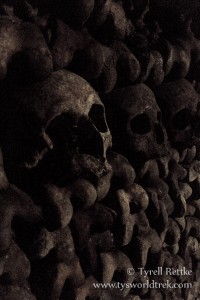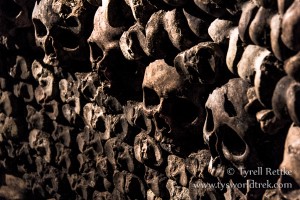I have wanted to see the catacombs beneath Paris for years. I’d seen programs about them and find the story fascinating. In the late 1780s, the city of Paris had reached a crisis. The dead were overflowing the cemeteries, being pushed out into cellars of nearby buildings and taking up large sections of the city. At the same time ancient stone mines and quarries beneath the city from the days of the Romans on were starting to collapse causing massive damage to the streets and buildings of the city.
After a massive project to map and catalog the underground passages, a solution to both problems was found. For nearly 3 years, a procession of carts draped in black cloths, and chanting priests the Cemetery of the Innocents to the old stone mines, where the stones to build the city had come from. The catacombs continued to collect remains until 1814, as the other cemeteries in Paris were emptied into the dark recesses of the ancient stone mines. It was in 1810 that the second Quarry Inspector, Louis-Étienne Héricart de Thury, transformed the catacombs, which had been just a bone repository, into the painstakingly arranged sepulture we know today. Now over 6 million bodies are thought to occupy the vaults and passages, and form the intricately decorated assemblages of bones that we see today.
I had read that the line for the catacombs was almost always wrapped around the block, so I decided to go early, right at opening, to avoid the crowds. I arrived 20 minutes early, to a line. Wrapped around the block. I’d like to say it went quickly, but the truth is it took 2.5 hours to reach the door. I know there are tickets you can buy that give you a front of line pass, through a tour company, which would be well worth the extra money if you can’t stand in line for what ever reason, but if you can, it’s much cheaper to just stick it out in line.
Once I reached the entrance, I paid my admission fee and also sprung for the audio guide for a few euro extra. I then started down the circular stair case. I descended 131 concrete steps the 60 feet to the start of the stone mines. There were several posters telling the history of the quarry and my audio guide rambled on. After about 15 minutes, we arrived at the entrance to the first of many chambers containing the remains of the 6 million people interred here. There was a sign asking you to not use flash photography, and not touch any remains.
 The air below ground is damp and cool, a constant 57 degrees all year. On both sides of the hallway are short walls, about 4 feet tall, stacked with femur bones and the occasional skull. The halls are very dark, the floor is bare ground, compacted by the years of visitors. The skulls leer at passers by, arranged in various patterns.
The air below ground is damp and cool, a constant 57 degrees all year. On both sides of the hallway are short walls, about 4 feet tall, stacked with femur bones and the occasional skull. The halls are very dark, the floor is bare ground, compacted by the years of visitors. The skulls leer at passers by, arranged in various patterns.
It was very difficult to photograph in the dark pathways. The lack of light required a higher ISO and very slow shutter speed. Without using a flash, I managed to still get a handful of shots that I liked.
 The audio guide droned one, speaking about the pre-catacombs time, the emergencies of the collapses, the transporting of the bones, and the various famous and important settings in the morbid walk way that would be of interest. A well that provided the workers with fresh water, apparently with magic properties. A carved replica of a prison island.
The audio guide droned one, speaking about the pre-catacombs time, the emergencies of the collapses, the transporting of the bones, and the various famous and important settings in the morbid walk way that would be of interest. A well that provided the workers with fresh water, apparently with magic properties. A carved replica of a prison island.
There were the occasional posters that gave some information, but the most of the catacombs was left as it was in the 1800’s. There were Latin inscriptions, poems, and reminders of who helped to create the catacombs.
The walk is not all that long, and soon enough, all the audio guide segments were played, and the climb back up to the surface begins. 80 steps up and an unassuming door leads you to the street. There is no fan fare, no attendant waiting. Just a side street and a few people looking dazedly up and down the road, trying to get their bearings. The warm Parisian air starts to beat down on me, as I turn and begin the long walk back to the hostel.
 The thing that really strikes me about the catacombs is the lack of names. In most cemeteries or other areas of interment, its very important to have the names of those that rest there. It’s the last way to be immortalized. In the catacombs, there is no long list. Only a handful of tombstones. These 6 million souls that are buried here, while many are known, their exactly location is not, and one wouldn’t know they were there just by visiting. There are almost no individual memorials to the dead.
The thing that really strikes me about the catacombs is the lack of names. In most cemeteries or other areas of interment, its very important to have the names of those that rest there. It’s the last way to be immortalized. In the catacombs, there is no long list. Only a handful of tombstones. These 6 million souls that are buried here, while many are known, their exactly location is not, and one wouldn’t know they were there just by visiting. There are almost no individual memorials to the dead.
 We all end up the same way at some point, but many of us at least get a way to be remembered by many people in the form of tombstones. For these 6 million people, and their descendants, there is no tombstone to visit. Only a massive monument to the dead of Paris as a whole.
We all end up the same way at some point, but many of us at least get a way to be remembered by many people in the form of tombstones. For these 6 million people, and their descendants, there is no tombstone to visit. Only a massive monument to the dead of Paris as a whole.
